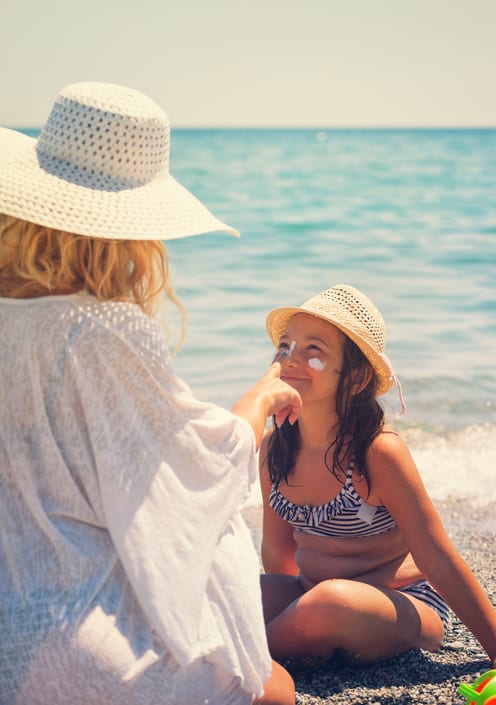Medicine or Malarkey: Can Clouds Be Your Sunscreen?
June 17, 2015

Summertime means fun in the sun, from picnics and outdoor sports to lounging on the beach and in backyard pools. To safely partake of all these great outdoor activities, it’s essential to protect yourself from overexposure to the sun. Skin cancer is the most common form of cancer in America: The EPA estimates that “90 percent of non-melanoma skin cancers and 65 percent of melanoma skin cancers are associated with exposure to ultraviolet (UV) radiation from the sun.” That means preventative measures should be taken when dealing with the sun. You may have heard many theories about how to do that — including the idea of clouds acting as your sunscreen. Let’s explore that and other ideas you may have overheard about sun protection.
“Clouds Are My Sunscreen” – talk about malarkey! As you’ve probably heard from your mother or lifeguard (who were correct — and rightly concerned for your health), you can indeed still get sunburned on cloudy or partly cloudy days. 80% of the sun’s UV rays still penetrate clouds.
Other common misconceptions:
- “Tanning Beds Are a Safer Alternative” – Despite what you might be told about “controlled doses” of UV radiation, tanning salons typically administer heavy doses of focused UV radiation. You’re exposing yourself to high levels of UVA rays which prematurely age your skin. According to SkinCancer.org: “Indoor tanners are 74% more likely to develop melanoma, than those who have never tanned indoors.” Wearing sunscreen in tanning beds does not make them any safer.
- “A Base Tan will Help Prevent Sunburn” – Scientists have largely debunked the idea that there is any benefit behind getting a preemptive “base tan” via tanning bed or the sun. You can’t change your skin type by increased exposure (if you’re pale or fair, that’s not going to change). Any change in skin color you experience through tanning is technically skin damage, so exposing yourself to additional UV radiation before a cruise, beach trip, etc. only increases your chances of long-term health risks.
- “Dangerous Chemicals in Sunscreen are Worse Than Sun Exposure” – Sunscreens are for the most part safe to use and effective when used properly. The chemicals in sunscreens are all FDA approved. If you have skin allergies, read labels carefully and avoid lotions that contain alcohol, fragrances and preservatives that might cause irritation. If you’re concerned about certain chemicals as a consumer, you can avoid products with avobenzone and oxybenzone.
What’s Actually Happening When You’re Sunburned?
UV rays damage your unprotected skin, killing cells and causing blood vessels to dilate and leak fluid, resulting in the signature inflammation (redness, blisters, etc.) UVB rays are the main cause of sunburn effects on the surface of the skin. They can directly affect skin cell DNA, and are the leading primary cause of skin cancer. The less intense UVA rays cause the long-term skin damage (wrinkles, etc.), and also increase risk of skin cancer.
What is the difference in a Sunburn and Sun Poisoning?
Anyone can receive a sun burn within 15 minutes of being exposed to UV rays without protection. Redness and discomfort from a sunburn can take a few hours to present itself, often times leading to a more severe burn, as people are not prompted to seek shade or put on sunscreens. But what is sun poisoning? Sun poisoning or a severe sunburn occurs over an extended period of over-exposure to the sun, and has the following symptoms:
- Skin redness and blistering
- Pain and tingling
- Swelling
- Headache
- Fever and chills
- Nausea
- Dizziness
- Dehydration
Treating Sun Poisoning
So what do you do if you sunburn has progressed into sun poisoning?
- Get out of the sun.
- Take a cool (not cold) shower or bath or apply cool compresses.
- Drink extra fluids for a few days.
- Take ibuprofen or acetaminophen to relieve pain.
- Use aloe gel or a moisturizer.
- Completely cover sunburned areas when going outside.
It is also very important to seek immediate medical attention at an ER or urgent care location such as CareSpot when the following symptoms present themselves:
- Blistering of the skin
- Severe Sun Burn of a Large Area of Skin
- Pain on the affected area
- Facial swelling
- Fever and chills
- Upset Stomach
- Headache, confusion or faintness
- Symptoms of dehydration
How to Protect Yourself?
- Always wear SPF of 30 or higher when outdoors.
- Try to avoid direct sunlight between the hours of 10 a.m. and 2 p.m. when the sun is at its hottest
- Wear extra protection such as long sleeves when in the sand, water and snow as it can intensify the sun’s rays.
- Protect your eyes with sunglasses, your face with a hat and your arms with long sleeves.
- Don’t forget your neck! Try to wear collared shirts when possible.
